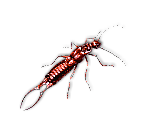European Earwig
Image is not to scale. |
General Characteristics: - Male forceps 4 to 8 mm - Female forceps 3 mm - Tegmina 2 mm. - Male forceps vary from about half as long to longer than the abdomen, broadened basally, with crenulated teeth basally and on beginning of curvature of inner margin - Antennae have 12 to 15 segments - The adult is rich reddish-brown, with wing covers and legs dull yellow brown, and the wings completely developed Reproduction: - The female lays a clutch of eggs underground, which she tends and grooms in order to keep it clean and safe - The immature earwigs are basically like miniature, undeveloped versions of the parents - With wings developing gradually on the outside of the body with each molt - The number of segments in the antennae also increasing with each molt, and the forceps developing from thin rods into the characteristic shapes of the adults. - The female continues to look after them after hatching (at least in the early stages).
Signs of Infestation: - European earwigs spend the day time in cool, dark, inaccessible places such as flowers, fruits, and wood crevices - Has been known to cause significant damage to crops, flowers, and fruit orchards when at high population levels - Common to find them wedged among petals of fresh cut carnations, roses, dahlia and zinnia
Control Techniques: - Close and seal as many openings as possible through which the earwigs can enter. This procedure is time consuming and may require a dedicated long term effort. -Ensuring all areas are dry will limit harbourage - Keeping exterior lights off overnight will reduce attraction to structure Myers, P., R. Espinosa, C. S. Parr, T. Jones, G. S. Hammond, and T. A. Dewey. 2008. "The Animal Diversity Web" (online). Accessed January 12, 2010 at http://animaldiversity.org. “Species Forficula auricularia - European Earwig” (On-line). Iowa State University Entomology. Accessed Jan.
|


